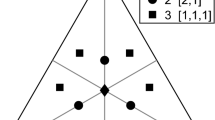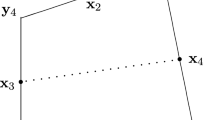Abstract
In one dimension, nodal locations that are distinct are necessary and sufficient to ensure that a unique polynomial interpolant exists for data provided at a set of nodes, i.e. that the set of nodes is unisolvent. In multiple dimensions however, unisolvency for a polynomial interpolant of degree p is not ensured even with nodal locations that are distinct and a set of n nodes, with n equal to the cardinality of a set of polynomial basis functions of at most degree p. In this paper a set of equations is derived for simplices of one to three dimensions with symmetrical nodal distributions to identify a combination of symmetry orbits that can provide a unisolvent set of nodes. The results suggest that there is a unique combination of symmetry orbits that can provide a unisolvent set of nodes for each degree of polynomial interpolant. Consequently, all other combinations of symmetry orbits cannot provide a unisolvent set of nodes for a degree p polynomial interpolant. This is verified numerically up to degree 10 for triangles and degree 7 for tetrahedra. The results suggest that the same is also true for higher-order polynomial interpolants. This significantly reduces the number of combination of symmetry orbits that needs to be considered. For example, for a tetrahedron with a degree seven interpolant, only one combination of symmetry orbits needs to be considered instead of the 161 different combinations of symmetry orbits that provide a set of nodes with n equal to the cardinality of the set of basis functions of at most degree seven. For a symmetrical nodal distribution in a simplex, the conditions presented are necessary but not sufficient to have a unisolvent set of nodes for polynomial interpolation.



Similar content being viewed by others
Data availability
Enquiries about data availability should be directed to the authors.
References
Blyth, M.G., Luo, H., Pozrikidis, C.: A comparison of interpolation grids over the triangle or the tetrahedron. J. Eng. Math. 56(3), 263–272 (2007). https://doi.org/10.1007/s10665-006-9063-0
Bos, L.: On Certain Configurations of Points in \(\mathbb{R}^n\) Which Are Unisolvent for Polynomial Interpolation. J. Approx. Theory 64, 271–280 (1991)
Briani, M., Sommariva, A., Vianello, M.: Computing Fekete and Lebesgue points: Simplex, square, disk. J. Comput. Appl. Math. 236(9), 2477–2486 (2012). https://doi.org/10.1016/j.cam.2011.12.006
Chen, Q., Babuška, I.: The optimal symmetrical points for polynomial interpolation of real functions in the tetrahedron. Comput. Methods Appl. Mech. Eng. 137(1), 6 (1996). https://doi.org/10.1016/0045-7825(96)01051-1
Chung, K.C., Yao, T.H.: On Lattices Admitting Unique Lagrange Interpolations. SIAM J. Numer. Anal. 14(4), 735–743 (1977). https://doi.org/10.1137/0714050
Ciarlet, P.G.: Finite Element Method for Elliptic Problems. In: Studies in Mathematics and Its Applications, vol. 4, 1st edn. North-Holland Publishing Co., Amsterdam-New York-Oxford (1978)
Farouki, R.T., Goodman, T., Sauer, T.: Construction of orthogonal bases for polynomials in Bernstein form on triangular and simplex domains. Computer Aided Geometric Design 20(4), 209–230 (2003). https://doi.org/10.1016/S0167-8396(03)00025-6
Fortin, M., Soulie, M.: A Non-Conforming Piecewise Quadratic Finite Element on Triangles. Int. J. Numer. Meth. Eng. 19(4), 505–520 (1983). https://doi.org/10.1002/nme.1620190405
Gasca, M., Sauer, T.: Polynomial interpolation in several variables. Adv. Comput. Math. 12, 34 (2000)
Hesthaven, J.S., Teng, C.H.: Stable Spectral Methods on Tetrahedral Elements. SIAM J. Sci. Comput. 21(6), 2352–2380 (2000). https://doi.org/10.1137/S1064827598343723
Hesthaven, J.S., Warburton, T.: Nodal Discontinuous Galerkin Methods: Algorithms, Analysis, and Applications. No. 54 in Texts in Applied Mathematics. Springer, New York (2008)
Hicken, J.E., Del Rey Fernández, D.C., Zingg, D.W.: Multidimensional Summation-by-Parts Operators: General Theory and Application to Simplex Elements. SIAM J. Sci. Comput. 38(4), A1935–A1958 (2016). https://doi.org/10.1137/15M1038360
Ibrahimoglu, B.A.: Lebesgue functions and Lebesgue constants in polynomial interpolation. J. Inequal. Appl. (2016). https://doi.org/10.1186/s13660-016-1030-3
Kobayashi, K., Tsuchiya, T.: A priori error estimates for Lagrange interpolation on triangles. Appl. Math. 60(5), 485–499 (2015). https://doi.org/10.1007/s10492-015-0108-4
Lee, S.L., Phillips, G.M.: Construction of Lattices for Lagrange Interpolation in Projective Space. Constr. Approx. 7(1), 283–297 (1991). https://doi.org/10.1007/BF01888158
Liu, Y., Vinokur, M.: Exact Integrations of Polynomials and Symmetric Quadrature Formulas over Arbitrary Polyhedral Grids. J. Comput. Phys. 140, 122–147 (1998)
Marchildon, A.L., Zingg, D.W.: Optimization of multidimensional diagonal-norm summation-by-parts operators on simplices. J. Comput. Phys. 411, 109380 (2020). https://doi.org/10.1016/j.jcp.2020.109380
Rapetti, F., Sommariva, A., Vianello, M.: On the generation of symmetric Lebesgue-like points in the triangle. J. Comput. Appl. Math. 236(18), 4925–4932 (2012). https://doi.org/10.1016/j.cam.2011.11.023
Roth, M.J.: Nodal Configurations and Voronoi Tessellations for Triangular Spectral Elements. Ph.D. thesis (2005)
Saniee, K.: A Simple Expression for Multivariate Lagrange Interpolation. SIAM Undergrad. Res. Online 1(1), 1–9 (2008). https://doi.org/10.1137/08S010025
Taylor, M.A., Wingate, B.A., Vincent, R.E.: An Algorithm for Computing Fekete Points in the Triangle. SIAM J. Numer. Anal. 38(5), 1707–1720 (2001)
Witherden, F.D., Park, J.S., Vincent, P.E.: An Analysis of Solution Point Coordinates for Flux Reconstruction Schemes on Tetrahedral Elements. J. Sci. Comput. 69(2), 905–920 (2016). https://doi.org/10.1007/s10915-016-0204-y
Witherden, F.D., Vincent, P.E.: An Analysis of Solution Point Coordinates for Flux Reconstruction Schemes on Triangular Elements. J. Sci. Comput. 61(2), 398–423 (2014). https://doi.org/10.1007/s10915-014-9832-2
Acknowledgements
The authors would like to thank Tristan Montoya, Prof. Masayuki Yano, and Prof. David Del Rey Fernández for several helpful discussions and for their help to improve this paper. Furthermore, the authors would like to thank the anonymous reviewer for several helpful suggestions, which helped significantly improve this paper. Finally, the authors acknowledge the financial support provided by the Government of Ontario through the Ontario Graduate Scholarship and the Government of Canada for the Vanier Canada Graduate Scholarship.
Funding
The authors have not disclosed any funding.
Author information
Authors and Affiliations
Corresponding author
Ethics declarations
Conflict of interest
The authors declare that they have no conflict of interest.
Additional information
Publisher's Note
Springer Nature remains neutral with regard to jurisdictional claims in published maps and institutional affiliations.
Rights and permissions
About this article
Cite this article
Marchildon, A.L., Zingg, D.W. Unisolvency for Polynomial Interpolation in Simplices with Symmetrical Nodal Distributions. J Sci Comput 92, 50 (2022). https://doi.org/10.1007/s10915-022-01904-w
Received:
Revised:
Accepted:
Published:
DOI: https://doi.org/10.1007/s10915-022-01904-w




